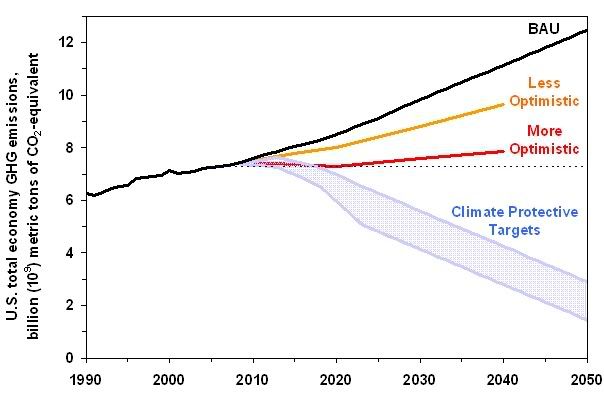New Analysis Shows Energy Bills Would Let Global Warming Emissions Rise for Decades
FOR IMMEDIATE RELEASE
(Washington – September 24, 2007) A new analysis released today by Environmental Defense shows that energy legislation passed by the House and Senate would let greenhouse emissions continue to increase for the next three decades, even if the best fuel-saving and renewable energy provisions in both bills were combined in conference committee.
The analysis underscores the urgent need for this Congress to pass comprehensive climate change legislation that reduces emissions far below today’s levels by the middle of this century.
“Most scientists say we need to cut emissions around 80% below current levels. These bills cut 0% below current levels,” said Steve Cochran, national climate campaign director at Environmental Defense. “They certainly have important provisions and we hope they pass, but they cannot be the last word on climate change from this Congress.”
“These energy bills aim at some important goals – promoting energy independence, boosting renewable energy sources, and raising auto efficiency standards. But they will not manage the global warming problem,” said Elizabeth Thompson, legislative director at Environmental Defense. “Even the best energy bill cannot substitute for comprehensive climate legislation” added Thompson.
Congress is poised to begin conference negotiations to reconcile the two energy bills, H.R. 6 passed by the Senate and H.R. 3221 passed by the House. Each contains different provisions designed to reduce dependence on fossil fuels: among other things, the House bill includes a Renewable Portfolio Standard (RPS) that would boost the percentage of electricity generated from renewable sources to 15% in 2020 and maintain that level through 2039, and the Senate bill aims to raise the Corporate Average Fuel Economy (CAFE) standard for cars and light trucks to 35 miles-per-gallon in 2020.
Environmental Defense’s analysis examines how well U.S. greenhouse gas emissions might be reduced under a law that incorporates the key provisions of both bills. The result is a set of emissions reduction scenarios for more optimistic and less optimistic expectations for the outcome of the conference and implementation of the final law.
Under the more optimistic scenario – one that assumes the best bill out of conference and full implementation by federal agencies – greenhouse gas emission levels would still be where they are today in 2020, and 11 percent higher in 2040. Under the less optimistic assessment – which assumes weaker CAFE standards and fewer actions on oil savings – emissions would be 35 percent above 2005 levels in 2040.
The full analysis is available online at www.environmentaldefense.org/energybill.
The chart below depicts the more optimistic and less optimistic energy bill emissions reduction scenarios, compared with business-as-usual U.S. emissions projections and the climate protection goals outlined by the U.S. Climate Action Partnership.

With more than 3 million members, Environmental Defense Fund creates transformational solutions to the most serious environmental problems. To do so, EDF links science, economics, law, and innovative private-sector partnerships to turn solutions into action. edf.org
Latest press releases
-
Gov. Newsom’s Can-Do Budget Proposal for Zero-Emission Vehicles Will Reduce Costs and Deliver Enormous Benefits for Californians
January 9, 2026 -
Trump EPA Takes Final Steps on Rule Expected to Overturn Endangerment Finding, Clean Vehicle Standards
January 9, 2026 -
California Shows Climate Policy is an Affordability Solution, Needed Now More than Ever
January 8, 2026 -
House Passes Funding Bills with Important Guardrails on President Trump
January 8, 2026 -
Arizona Attorney General Secures Historic Groundwater Settlement for Rural Arizona
January 8, 2026 -
Weakening Fuel Economy Standards for Cars and Trucks Would Waste Gas, Cost Money, Increase Pollution – EDF Testimony
January 8, 2026










